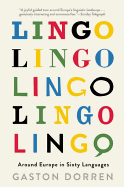
Languages have been shaped by geography, wars, political ideologies and policies, and their proximity to other languages. In Lingo: Around Europe in Sixty Languages, his first book translated into English, Dutch linguist and journalist Gaston Dorren offers what he calls "an amuse-bouche" of European language and linguistics, "a guidebook of sorts, but in no sense an encyclopedia."
Quirks of particular languages occupy some of his chapters: the profusion of belittling diminutives for women in Italian; awkward counting systems; the linguistic effects of mountains and the "astonishingly ornate" word forms of Welsh. In others, Dorren uses one language to illuminate a broader topic, such as the ongoing disappearance of grammatical cases across Europe. He is an enthusiastic polyglot who can speak six languages and read nine more, and although he sees many ways in which Europeans could overcome some of their linguistic differences, much of his book tells the story of a culturally fragmented collection of peoples devoted to staying that way. For example, he notes that there is no such thing as Norwegian, only regional dialects and four written forms "ranging from 'moderate' (more Danish) to 'radical' (less so)." Two of these written forms are official. Both are taught in their schools, including the two sets of spellings. "There are even Norwegian-Norwegian dictionaries."
For language lovers and those who enjoy obscure facts, European culture and politics--or all of the above--Lingo will be an entertaining book to dip into, a tasting menu of the pleasures of languages. --Sara Catterall

